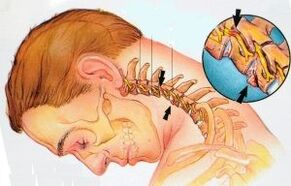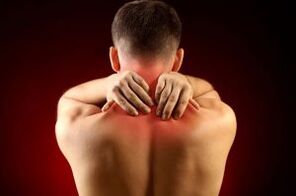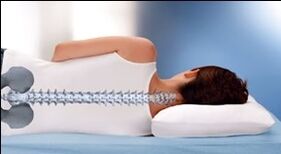
To the question: how to treat osteochondrosis of the cervical column, there is an answer: to influence yourself the cause of this disease, if you are not an acute period.
Medicine deals with the study - the symptoms of the disease, not the cause.Therefore, do not expect doctors, do not throw money in vain on ointments, teas, injections, physiotherapy, simulators, massage.None of the funds listed will help you.
It is therefore categorically a question of saying that my personal experience in the treatment of cervical osteochondosis, which I will be happy to share, in the hope that this will help you to face this problem.
However, the success of treatment will depend on several conditions:
- Your desire to help you;
- Ready to understand the real cause of cervical osteochondosis;
- Compliance with the strictest self-discipline in treatment.
What you need to know about osteochondrosis of the cervical column
To answer the question:How to treat osteochondrosis of the cervical column,It is necessary to understand the cause of the disease.To understand this, you will have to turn to the anatomy of the spine.
Our spine is a strong but flexible case for vital blood vessels and nervous trunks.Supporting the spine in good condition means not having health problems.
But we, out of ignorance or because of a frivolous attitude towards health from an early age, carefully deal with the spine: load it too much, take uncomfortable poses, sitting for hours on the computer or table during sitting work, we spend a lot of time driving a car in a state of time, we have a posture of overlying and incorrect, etc.

The cervical column is the most mobile.It consists of seven vertebrae, between which there are elastic intervertebral discs.They are clearly visible in the figure.The discs make the spine flexible and give it at the same time.
Each intervertebral disc consists of a fibrous ring, inside which there is a pulpoose nucleus.
In the cervical column, the cerebrospinal nerve and the vertebral artery pass, which, through the branched nerves and the blood vessels, nourish not only the head with the brain, but also the organs of the shoulder belt.
Cervical osteochondosis is changes in the intervertebral discs of the cervical column following physical, inflammatory or mental exposure.The elasticity and resistance of the intervertebral discs decrease, while their height also decreases.
In the future, if you do not treat the disease, the fibrous ring of the intervertebral disc is pressed and distorted, which can lead to projection.In more serious cases, the fibrous ring of the disc breaks and the pulp nucleus comes out in the form of a hernia, while tightening the nerve endings emerging from the vertebral holes, as shown in the figure.
Thus, the cause of cervical osteochondosis is a change in the intervertebral discs in the cervical column in the bottom of the weak muscles.In addition, even a slight muscle tension can cause the vertebrae to move, as a result of which the nerve endings are compressed and pain occurs.
But there are a lot of factors, as a result of which there is a change of records.It is a sedentary lifestyle, a hereditary predisposition, metabolic disorders, injuries, and the deposit of salts in the cervical column and others.
How does cervical osteochondosis manifest?All symptoms indicate that due to changes in intervertebral discs, innervation and blood supply to the brain, head, neck and shoulder belt are altered.Consequently, the symptoms of cervical osteochondosis are headache on the back of the head and temples, Lurdling with a lively turn of the head, noise in the ears, a decrease in visual acuity, deterioration of hearing, pain in the neck, shoulders, shoulder blades, hands and sometimes in the heart.
Lurdling with a lively turn of the head, noise in the ears, a decrease in visual acuity, deterioration of hearing, pain in the neck, shoulders, shoulder blades, hands and sometimes in the heart.
If cervical osteochondosis is not treated, then due to altered cerebral circulation, diseases develop such as: migraine, hypertension, vegetable dystonia, hearing problems, eyes, coordination, with cardiovascular and respiratory systems.In advanced cases, brain ischemia and stroke can develop.
Personal experience in the treatment of cervical osteochondosis
Diagnosis is a cervical osteochondosis, I was given a neuropathologist at the age of 45.After examining the image of the X-rays of my neck, he wrote on the map next to the diagnosis: the height of the discs between the vertebrae C5-C6 and C6-C7 was considerably reduced.I was tormented by frequent headache, ringing in my ears, pain in my neck.
The question arose:How to treat osteochondrosis in the cervical column.The doctor calmly "reassured" me that osteochondrosis is impossible to heal completely, because the intervertebral discs have been distorted.He does not prescribe me cheap, at these prices, the ointment and advised me to sit directly at the table.It was the 90s, I bought the ointment according to the recipe of a neuropathologist in a left pharmacy.But the relief ointment did not bring, the pain poisoned my life.
On the recommendation of knowledge, I turned to the services of a specialist paid in manual therapy with higher medical training.After he, having felt the cervical vertebrae turned his head, it seemed to be 180 degrees, he became easy, lit and not painful.However, the procedure was clearly dangerous.The manualist warned that for three days, you should sit directly at the table, not in a favorite pose.

I followed the recommendations for two days, then I forgot.A few days later, my condition again became the same as before visiting a doctor - a manualist.This experience explained to me how to treat osteochondrosis in the cervical column.Having reduced the whole literature on osteochondrosis, I realized that I had to independently affect the cause of the disease.Doctors here are not assistants.It is impossible to change the deformation of the discs, but you can stretch the cervical column, and thus reduce the pressure on the nerve endings and the blood vessels.
In the house, we always had a horizontal bar in the morning, hanging on it, you get a good section of the whole spine, except for the neck.I tried in many ways to stretch the neck and I developed my own system for the treatment of cervical osteochondosis:
- Changed his posture.It was not easy and not immediately arrived, but self-discipline and motivation helped me, to feel healthy.I have often looked in the mirror to my posture, I checked it, going near the wall: my head should touch the wall, that is to say to be on the same line with heels.I always try to hold my head and my right shoulders.Today, when I am 60 years old, I have a better posture than it was twenty years ago.
- Every day in the morning and evening, I do the "turtle" exercise of the Tao revitalization system.Sometimes I do it more often if I feel tensions or hardening in the neck, upper back or shoulders.Make the turtle of the turtle with seat as in the figure:
- Lower your chin to your chest, pulling your head behind your back with your head.Inspire slowly.At that time, the back of the neck extends and the shoulders fall;
- Exhale slowly, take the back of your head downwards, as if you wanted to touch them on the back of the neck.The chin stretches, the throat extends slightly.The shoulders rise on both sides of the head, as on the point of touching the ears;
- Repeat this cycle 10 to 12 times, trying to do everything slowly.
The turtle exercise contributes to the sure stretch of the cervical column, strengthens the muscles of the neck and shoulders, eliminates fatigue, hardening and pain, improves metabolism and rejuvenating the body.
- In addition to the "turtle", I do an exercise to relax the whole shoulder belt, also sitting:
- Lift and lower your shoulders 10 times;Tilt your head slowly - to the right 10 times towards each shoulder;
- Tilt your head slowly - back 10 times;
- Tilt the head first to the right (the right ear to the right shoulder), then slowly, stretching the neck and throwing your head, roll it on the spine and the left shoulder.Then from the left shoulder - to the right.Make 10 rockets at each shoulder;
- Relax again, straighten the spine again, balance the body weight on the coccyx and start to slowly circular movements with a torso from left to right, then 10 times from right to left.At the same time, the head, the shoulders, the hands are relaxed in rotation.
This exercise, in addition to relaxation, awakens the healing forces of the body, normalizing the energy nutrition of all cells and organs.
- When I work on the computer for a long time, I put a neck collar (it can be bought in a pharmacy).I am not sitting in long, an hour or two.This allows you to keep your head straight.
- If I noticed that from an clumsy pose, for example, seated near the TV or working in the country, I had a ring in my ears or my headache, I relax immediately (as read here), after which I exercise the turtle.The call and pain go within 5 to 10 minutes.

Relaxation and stretching of neck muscles and shoulder belt should be part of your daily life, so you will feel good, having a diagnosis like cervical osteochondosis.
Before you start the exercises, see your doctor.
Here, I want to note that such a treatment of the disease is possible outside of exacerbation.If you have an acute period of cervical osteochondosis with counterfeit nerves of hypothermia or any infection, consult a doctor and take blocking, injections, etc.Prescribed as soon as the exacerbation passes, you can apply my method.
You are also a note: you can relax your neck muscles by taking a hot shower on your neck or taking you in the bath.
Conduct a mobile lifestyle, but avoid the clear turns of the head, a heavy burden, because the shoulder muscles are tense, whose spasm will move the vertebrae and infer the roots of the nerves and blood vessels in the neck.
Sleep on a small pillow, often in fresh air, change negative thinking in positive so that your constraints do not betray the cervical zones and shoulder and do not exacer the symptoms of osteochondosis.

Join good nutrition.Exclude sugar and white bread, bakery products from your diet.Eat more vegetables, fruit and cereals.
Now, I hope you understand how to treat osteochondrosis in the cervical column.
Trust yourself and live without pain with your cervical osteochondosis!






















